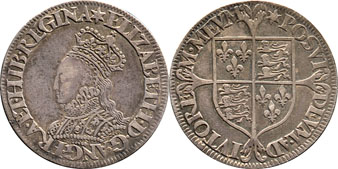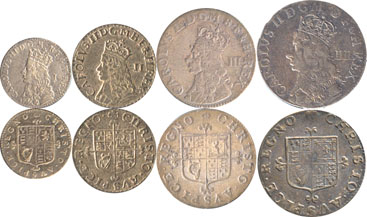 |
 |
| Elizabeth I Milled Shilling | Elizabeth I Hammered Shilling |
 |
 |
| Elizabeth I Milled Shilling | Elizabeth I Hammered Shilling |
England's coinage for its early history was hammered - struck by hand. As coinage could be irregular, unevenly struck and otherwise imperfect, higher quality was desired.
The first attempt at milled coinage was made in 1560-61 during the reign of Elizabeth I. Eloye Mestrelle, a Frenchman, was commissioned to produce machine-made coinage using a screw press. As part of the machinery was powered by a horse-drawn mill, these coins became known as "mill money". One such coin is shown above on the left - a milled shilling. These coins were better struck and more regular than the hammered issues, as shown on the right. Although of higher quality they took longer to produce, however. The fact that Mestrelle was French, and the fact his coworkers felt they may be eventually replaced with machines led to animosity between them, and Mestrelle's dismissal in 1572. Six years later he was hanged for counterfeiting. After the experiment, production returned to hammered coinage. The hammered coin shown above was minted 1594-1596, more than 30 years after the milled coin.
 |
 |
| Charles I Halfgroat | Charles I 30 Shillings |
The next experiment was conducted in the 1630s. Nicholas Briot, another Frenchman, was commissioned by Charles I to produce milled coinage, this time by screw press. As before, the coinage was much better than the circulating coinage of the time, and once again, the coinage was unpopular for similar reasons. Briot had several series of coinages, both for England and Scotland. For England he struck coinage at the Tower Mint in London, and for Scotland at the Edinburgh mint. The coin on the left is a Briot pattern halfgroat. Although a denomination normally struck in silver, off metal strikes were made in copper as well including this one. The author is aware of two other specimens as of 2001 - one in the Hunterian Museum in Glasgow, and another in the British Museum. It was determined at the time that the Royal Mint has only a silver example, and neither copper nor silver examples are part of the National Numismatic Collection at the Smithsonian. As the silver coins share the same features as this one, such as the doubled B, it is presumed that a single set of dies struck both the silver and copper issues. The coin on the right is a Briot 30 Shilling coin of Scotland also struck with a screw press.
 |
| Charles II Undated Maundy Set |
One more attempt at milled coinage was made during the Commonwealth, but milled coinage did not become the official production method until 1662 with the issue of a silver crown, and with a gold 20 shilling coin and silver halfcrown and shilling in 1663. Although circulating coinage and not a true Maundy set, the "undated Maundy set" shown above, designed by Thomas Simon, was the first issue, minted 1664-65, of milled pennies through fourpence.
 |
| Charles II Pattern Farthings |
In 1665 a series of patterns were produced for milled farthings with dies by John Roettier, four of which are shown above. Note that the first two, Peck 424 and 434, show Charles II with curly flowing hair, while the second two, Peck 412 and 411, show the hair tied. Note also that Peck 411 is an off metal strike in silver. Peck indicates the long hair die was created by overcutting the tied hair die, as the curly hair extends far enough to obliterate the ties.